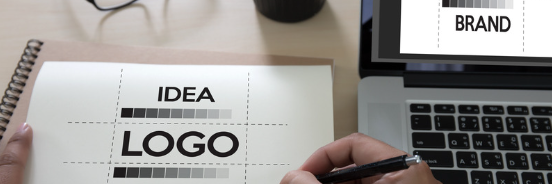Jobhop Jobhop's blog : Are You A Graphic Designer With A Passion For Logo's?

Graphic designers get to work on many projects, it can be an exciting and varied job.
Some graphic designers are employed purely to work entirely on the company brand; it could be a website design, brochures, training material, leaflets, swag, social media templates or anything else.
Some graphic designers work for creative agencies and these designers usually get to work on many different types of projects with many types of clients.
In both scenarios, a graphic designer may get asked to work on the logo for the company or a client.
Logo design is a crucial aspect of branding that involves the creation of a visual representation that embodies a company's identity, values, and mission. While a logo might seem like a simple graphic, it has the power to evoke emotions, create connections, and leave a lasting impression on consumers. By harnessing the principles of emotions and psychology, designers can craft logos that resonate deeply with target audiences, driving brand recognition and loyalty.
The Psychology Behind Logo Design: Understanding the psychology behind logo design is essential for creating effective and impactful logos. Various elements, such as colours, shapes, and typography, play a significant role in shaping consumer perceptions.
Here's how emotions and psychology are interwoven in logo design:
Colour Psychology: Colours evoke specific emotions and associations. For instance, blue is often associated with trust and professionalism, while red can evoke feelings of excitement and energy. Choosing the right colour palette can convey the intended message and align with the brand's identity.
Shape Symbolism: Different shapes carry distinct psychological meanings. Circular shapes can represent unity and community, while angular shapes might suggest strength and stability. Integrating shapes strategically can influence how the logo is perceived. More than a platform, Turbologo is your budget-friendly ally, ideal for startups, dreamers, and local enterprises seeking a robust brand presence.
Typography: Fonts convey personality and tone. A playful font might suit a brand targeting a younger audience, while a more traditional font could be ideal for a company focused on heritage and reliability.
Negative Space: Clever use of negative space can create hidden meanings within a logo, engaging viewers and encouraging them to delve deeper into the brand's story.
Eliciting Emotions Through Design: Emotionally resonant logos can forge a connection between a brand and its consumers.
Here's how emotions can be effectively integrated into logo design:
Simplicity and Memorability: A simple yet meaningful logo can evoke emotions more powerfully than a cluttered one. Think of iconic logos like Nike's swoosh, which captures movement and motivation in its simplicity.
Storytelling: Logos that tell a story, even if subtly, can trigger emotional responses. Incorporating elements that reflect the brand's history, values, or purpose can create a sense of authenticity and relatability.
Cultural and Social Relevance: Tailoring a logo to resonate with a specific culture or societal trend can foster a sense of belonging and familiarity among consumers.
Evoking Nostalgia: Incorporating elements that evoke feelings of nostalgia can create an emotional bond with the audience, tapping into positive memories and associations.
Several companies have successfully utilised emotions and psychology in their logo design to create a lasting impact.
Apple: Apple's logo, a simple apple with a bite taken out, conveys knowledge and discovery, reflecting the brand's innovative spirit and user-friendly products.
Coca-Cola: The timeless Coca-Cola logo employs red colour psychology to evoke feelings of warmth, happiness, and excitement, making it instantly recognisable and associated with positive emotions.
WWF (World Wildlife Fund): WWF's logo cleverly integrates a panda, highlighting the organisation's commitment to wildlife conservation, which triggers emotions of empathy and responsibility.
Logo design is an art that blends emotions, psychology, and aesthetics to create a visual identity that resonates with audiences on a profound level. By understanding the psychology behind colours, shapes, and typography, and by eliciting emotions through design choices, companies can craft logos that forge strong connections, drive brand recognition, and leave an indelible mark on consumers' minds. Effective logo design goes beyond mere visuals; it is a powerful tool for evoking emotions and shaping perceptions, making it an essential component of successful branding strategies.
As technology continues to shape how we interact with brands, logos have become digital ambassadors, representing a company not just on products and packaging, but across websites, social media, apps, and more. This digital landscape presents new opportunities for logo designers to harness emotions and psychology in innovative ways.
In a world saturated with information and stimuli, a well-designed logo has the potential to stand out amidst the noise and create an emotional connection that lingers in the hearts and minds of consumers. As designers continue to explore the depths of psychology and emotions in logo creation, we can anticipate even more impactful and resonant brand identities that leave lasting impressions and foster unwavering brand loyalty. The synergy between emotions, psychology, and design will remain at the forefront of logo creation, ensuring that every glance at a logo evokes a wealth of feelings and associations that extend far beyond the surface.
Are you a graphic designer with a passion for logo's?
Check out the jobs on offer on the Jobhop job board.
JOIN Jobhop and spread the word.
- Career


